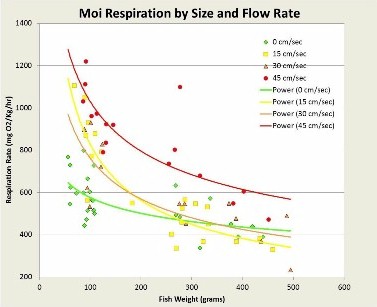Model Calibration
Laboratory studies on the growth and metabolic activity of larger-sized moi (Polydactylus sexfilis), a culturally and economically important Hawai’ian marine fish species were conducted.
We also completed similar studies of cobia, (Rachycentron canadum), an increasingly important and fast growing species used in mariculture in many tropical areas worldwide.
The results of these laboratory trials were used to construct mathematical physiological submodels for incorporation as computer code into AquaModel, adding to Atlantic salmon (Salmo salar), striped bass (Morone saxatilis) and sablefish (Anoplopoma fimbria). Little physiological information was previously available for any size of moi, and only very small, post larval cobia had previously been studied. Our studies of larger sized fish have provided information necessary to run simulations of operations and environmental impact for the growing mariculture industry in Hawai'i for moi and in the Caribbean Sea and other regions for cobia.
The focus of this work was to determine:
- The basal (resting) and active swimming respiration
- Excretion rates of ammonia and urea versus all total dissolved nitrogen components
- Fish fecal settling rates
- N and C digestibility
This information was then tested and compared to actual growth results to validate the model.

Moi respiration rates by fish weight and swimming speeds cm sec^-1
Methods
The work was conducted in cooperation with the Northwest Fisheries Science Center of NOAA in Seattle using a large recirculating seawater system through the assistance of NOAA staff Dr. Mike Rust and Mr. Thom Scott. Juvenile moi were donated by Mr. Randy Cates of Cates International and juvenile cobia donated by Dr. Michael Schwartz of Virginia State University. Water quality conditions in the recirculating seawater system were monitored continuously and were maintained well within acceptable ranges.
Results
There were differences between the species in respiration rates, with moi using significantly more dissolved oxygen than cobia. Behaviorally the fish were very different: the moi were more active and restless while the cobia were less active and more complacent. Fast swimming (45 cm sec^-1) respiration rates were about 30% higher for moi than cobia and declined monotonically with swimming rate. Cobia respiration rates declined with slower swim speeds, but irregularly as these fish were adept at resting their pectoral and caudal fins in the swim respirometer as an energy-saving behavior. The cobia data were corrected for this artifact before using the functions that were derived, although these fish have been observed in net pens to act in this manner at times.
Excretion rate studies indicated that significant missing dissolved nitrogen produced by the fish could be accounted for and modeled by using measurements of filtered total dissolved nitrogen. Previous studies have often focused only on dissolved inorganic nitrogen (nitrate + nitrite + ammonium) and sometimes additionally urea. We conservatively used total dissolved nitrogen results to calibrate the model, although not all of the nitrogen would be immediately available for phytoplankton or attached benthic vegetation uptake and growth.
Fecal settling rates were similar for both species at approximately 1.0 cm sec-1, similar to other marine fish that have been studied but much slower than salmon, resulting in better areal distribution and aerobic assimilation of the organic carbon containing wastes generated by fish culture. We used a novel technique that should have imparted less bias than prior trials that used fecal matter collected beneath net pens that were then bottled and moved to the laboratory for testing.
Apparent digestibility (intake minus output) of a standard diet was determined in order to assess the mass balance flow of carbon and nitrogen in the diet.
Extensive detail of the methods and results can be found in the final report.


